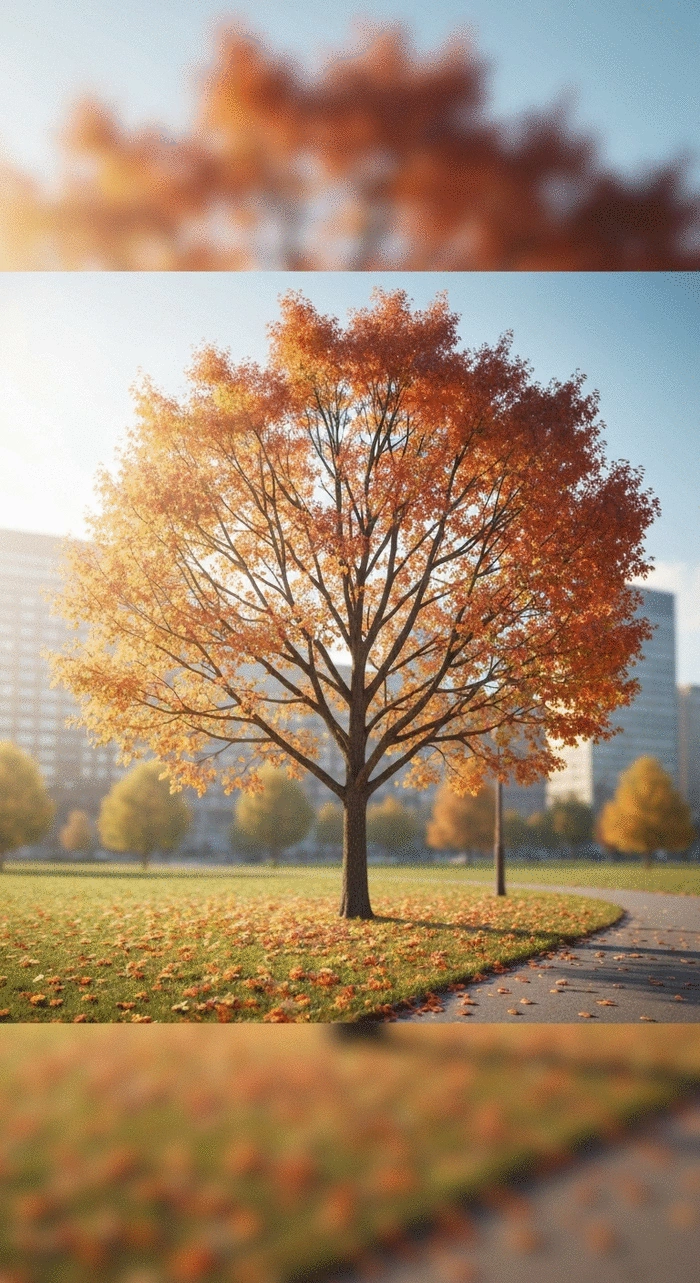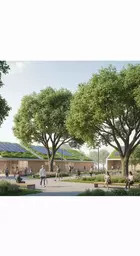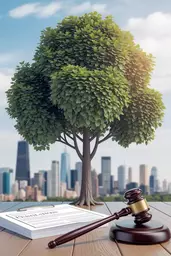Seasonal Weather and Urban Trees

Posted on: 2025-11-22
By: Keira Vallejo
By 2050, it's predicted that urban areas will house nearly 70% of the global population, making the preservation of our urban trees more important than ever. Understanding how seasonal weather affects these trees is not just about aesthetics; it's about maintaining a livable environment for future generations.
What You Will Learn
- Urban trees are essential for improving air quality, reducing urban heat, and supporting biodiversity.
- Seasonal weather patterns significantly influence tree health, requiring specific care strategies throughout the year.
- Engaging with the community through education and tree planting programs enhances urban forestry efforts and promotes responsibility.
- Successful tree care practices can be informed by case studies from cities like Phoenix and Baltimore, which adapt to their unique climates and community needs.
Seasonal Challenges for Urban Trees
Understanding how different seasons impact urban trees helps us ensure their longevity and health. Below is a visual representation of the challenges trees face throughout the seasons.
Winter Damage
Freezing temperatures can harm delicate buds and branches.
Summer Drought
Extended dry spells can stress trees, making them more vulnerable to pests and diseases.
Spring Growth Spurts
Warmer temperatures can stimulate rapid growth, requiring extra care to ensure trees are healthy.
Understanding the Connection Between Seasonal Weather and Urban Tree Longevity
Have you ever wondered how seasonal changes affect the trees in your neighborhood? Urban trees play a vital role in maintaining healthy city ecosystems, but their longevity is closely tied to weather patterns. By understanding this connection, we can appreciate the importance of nurturing our green companions, and that’s exactly what we strive for at Urban Canopy Blog!
These trees are not just beautiful additions to our streets; they are essential for improving air quality, providing shade, and enhancing our overall well-being. By recognizing their role, we can better appreciate why understanding seasonal weather is crucial for their care and longevity. Let's dive deeper into this fascinating relationship!
The Crucial Role of Urban Trees in City Ecosystems
Urban trees are more than just pretty sights; they contribute to a balanced city ecosystem. They help mitigate air pollution, reduce flooding, and support biodiversity. Without trees, our urban landscapes would struggle to provide these essential services. Consider the benefits of urban trees and noise reduction to fully appreciate their impact.
- **Air Quality Improvement:** Trees absorb pollutants, releasing oxygen and enhancing the air we breathe.
- **Temperature Regulation:** They provide shade, cooling urban areas and reducing the heat island effect.
- **Wildlife Habitat:** Trees offer homes and food for various species, promoting urban biodiversity.
Every tree planted is a step towards a healthier urban environment! As your urban forestry expert, I believe that understanding the crucial role these trees play is the first step towards ensuring their longevity.
Ecosystem Services Provided by Urban Trees
Urban trees bring a wealth of benefits to our communities. They offer a range of ecosystem services that contribute to our quality of life. Let’s explore some of the key services provided by our leafy friends!
- **Stormwater Management:** Trees absorb rainwater, reducing runoff and flooding during heavy rains.
- **Carbon Sequestration:** They capture carbon dioxide from the atmosphere, helping combat climate change.
- **Noise Reduction:** Trees can act as sound barriers, making urban areas quieter and more peaceful.
Each service plays a part in enhancing city life, making it essential to care for our trees year-round. Remember, these benefits are not just seasonal; they’re ongoing, emphasizing the need for consistent tree care!
Defining Seasonal Weather Patterns and Their Variations
Seasonal weather patterns can significantly impact tree health. Understanding these variations helps us make informed decisions about tree care. For instance, during winter, trees endure cold temperatures, while summer brings warmth and increased sunshine. If you are interested in seasonal urban tree care, understanding these patterns is crucial to keeping your trees healthy.
Different seasons can lead to various challenges for urban trees, such as:
- **Winter Damage:** Freezing temperatures can harm delicate buds and branches.
- **Summer Drought:** Extended dry spells can stress trees, making them more vulnerable to pests and diseases.
- **Spring Growth Spurts:** Warmer temperatures can stimulate rapid growth, requiring extra care to ensure trees are healthy.
By learning about these seasonal changes, we can better prepare our trees for the challenges they face. At Urban Canopy, we are committed to sharing insights that empower you to become a better steward of your urban landscape!
Quick Summary
Here's a brief recap of the key points discussed so far:
- Urban trees are essential for improving air quality, regulating temperature, and supporting biodiversity.
- Understanding seasonal weather patterns is crucial for tree care, helping to address challenges like winter damage and summer drought.
- Community engagement and education are vital for promoting tree longevity and fostering a sense of responsibility towards urban canopies.
Engaging with the Community: Sharing Knowledge and Practices
As an urban forestry expert, I believe that one of the most effective ways to promote tree longevity is by actively engaging with our communities! Sharing knowledge about the importance of trees and how they interact with seasonal weather can foster a sense of responsibility among residents. Whether it's through workshops, community events, or online platforms, spreading awareness can dramatically enhance the health of our urban canopies.
Have you ever wondered what questions people have about tree care? It's essential to address the common concerns that arise when discussing tree longevity and seasonal weather patterns. By providing clear answers and practical solutions, we can empower individuals to take better care of their green companions.
Frequently Asked Questions on Tree Longevity and Seasonal Weather
Let's tackle some *frequently asked questions* that often come up in conversations about tree care and seasonal impacts. Understanding these can help us nurture our trees effectively! Here are some common queries:
- What tree species are best suited for urban environments?
- How can I tell if my tree is suffering from stress due to weather changes?
- What are the signs that a tree needs more water during drought conditions?
- How can seasonal temperatures influence tree growth and health?
By addressing these questions, we can demystify tree care for everyone in our communities. It’s all about making tree maintenance accessible and inviting for all ages!
FAQs:
- What makes urban trees so important? Urban trees improve air quality, reduce urban heat, support biodiversity, and contribute to our overall well-being.
- Why is seasonal weather knowledge essential for urban tree care? Understanding seasonal weather patterns helps address specific challenges like winter damage, summer drought, and spring growth spurts, ensuring trees receive appropriate care throughout the year.
- How can I tell if my tree is stressed due to weather changes? Signs include wilting leaves, stunted growth, discolored foliage, and increased susceptibility to pests.
- What are some successful strategies that cities use for urban tree care? Cities like Phoenix focus on drought-tolerant species, while Baltimore emphasizes community involvement in tree planting.
Case Study Insights: Learning from Cities like Phoenix and Baltimore
When we look at cities like *Phoenix* and *Baltimore*, we see how different urban environments can teach us valuable lessons about tree longevity. Each city faces unique challenges and opportunities influenced by their climate and community practices. Here are some insights from these case studies: For example, Phoenix has developed successful programs for drought-tolerant species; to learn how to protect urban trees from heat, check out this article.
- **Phoenix** has developed extensive programs focusing on drought-tolerant tree species, which thrive in arid conditions and contribute to urban cooling.
- **Baltimore** emphasizes community involvement in tree planting, showcasing how collaboration can lead to increased tree canopy and healthier urban landscapes.
- Both cities utilize local climate data to inform their tree selection and care practices, ensuring trees are well-suited to their environments.
These examples highlight the importance of tailoring our tree care strategies based on local needs and circumstances. By learning from successful initiatives, we can adapt and inspire our own urban communities.
Community Engagement in Tree Planting Programs
One of my favorite ways to get the community involved is through organized tree planting programs. These events not only beautify our neighborhoods but also instill a sense of pride and responsibility among participants. Here’s how we can make these programs successful:
- **Host Workshops**: Educate community members about the benefits of trees and proper planting techniques.
- **Collaborate with Local Organizations**: Partner with schools, non-profits, and local businesses to maximize outreach.
- **Create a Tree Care Guide**: Provide participants with easy-to-follow instructions for maintaining the trees they plant.
- **Celebrate Successes**: Organize follow-up events to share growth updates and encourage ongoing care.
By working together, we not only enhance urban greenery but also build stronger community ties. It’s rewarding to see people come together for a common goal: a healthier, greener city!
Conclusion: Moving Forward with Seasonal Tree Management Strategies
As we reflect on the connection between seasonal weather and tree longevity, it’s clear that our actions can make a significant impact. By understanding how weather patterns affect urban trees, we can develop effective management strategies that promote their health and lifespan. To ensure your trees get the best care, consider the benefits of professional tree care.
Encouraging collaborative urban planning for sustainable tree canopy growth is essential. By working together, we can create vibrant, healthy urban spaces that benefit everyone. So, let’s get started on this journey toward a greener future!
Recap of Key Points
Here is a quick recap of the important points discussed in the article:
- Urban trees are vital for improving air quality, providing shade, and supporting biodiversity in city ecosystems.
- Understanding seasonal weather patterns is crucial for effective tree care, as different seasons pose unique challenges.
- Community engagement through workshops and tree planting programs can significantly enhance urban tree longevity and foster a sense of responsibility.
- Tailoring tree care strategies based on local climate data, as demonstrated by cities like Phoenix and Baltimore, is essential for successful urban forestry.
- Consistent tree care and maintenance are necessary year-round to ensure the health and longevity of urban trees.
 By 2050, it's predicted that urban areas will house nearly 70% of the global population, making the
By 2050, it's predicted that urban areas will house nearly 70% of the global population, making the
 Have you ever stopped to think about how the trees lining your city streets do more than just beauti
Have you ever stopped to think about how the trees lining your city streets do more than just beauti
 In urban environments, trees are often the unsung heroes contributing to our well-being and the over
In urban environments, trees are often the unsung heroes contributing to our well-being and the over